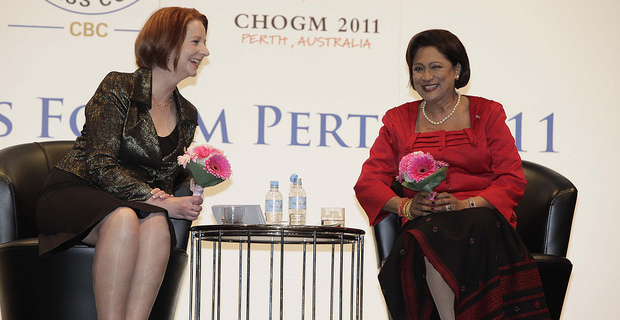Happy Commonwealth Day ... But Why?

Many Australians are probably not aware that today is Commonwealth Day—the day officially set aside “to promote the Commonwealth’s shared values of peace, democracy and equality.” And why would they? Despite the Commonwealth’s fading reputation, there is potential for it to become a critical force for development.
The association of 52 mostly former British colonies appears, on the surface at least, to be nothing more than an outdated relic of a bygone era. Yet, as outlined in Global Citizen’s submission to the Foreign Policy White Paper, the Commonwealth of Nations is well suited—even uniquely so—to addressing some of the greatest challenges of our time. These include the so far lacklustre implementation of the Sustainable Development Goals—the United Nation’s 17-point plan to eradicate extreme poverty, mitigate climate change and reduce inequality.
So, what unique value-add does this voluntary association, representing 2.2 billion people, bring to sustainable development efforts? First of all, it is definitely not what it contributes on the programmatic side of things. Successive surveys by both the UK and Australian governments have slammed the Commonwealth’s secretariat over its reportedly poor delivery of aid programs. And it has to be said that there are other organisations, including NGOs, better equipped to deliver this kind of on-the-ground work.
Polio eradication
Where the Commonwealth’s unique value lies is in its ability to convene a diverse number of countries around a common focused agenda that few, if any, other associations can emulate.
Take polio, for example: In the years leading up to the 2011 Commonwealth Heads of Government Meeting (CHOGM), outbreaks of poliovirus were occurring in places where it had not been seen for years. The disease seemed to be making a terrifying comeback even though it had previously been almost 99 per cent eradicated. In response, at the 2011 CHOGM held in Perth, then Prime Minister Julia Gillard brought numerous world leaders together to revitalise the global eradication effort. Millions of dollars in new funding from donor countries (Australia, the UK and Canada) were pledged. Importantly, the leaders of Pakistan and Nigeria—which accounted for the majority of polio cases at the time—pledged to place the effort amongst their respective governments’ top priorities.
Six years later, and the situation with polio is vastly different. Only 37 cases were reported across three countries last year (compared to 650 across 16 countries back in 2011). Challenges remain that may yet derail such progress, including a funding gap of more than US$1 billion (AUD$1.3 billion). But with the Commonwealth’s ongoing support, we stand on the cusp of making polio just the second human disease in history to be eradicated, after smallpox. Reassuringly, at the last CHOGM that took place in Malta in 2015, Maltese Prime Minister Joseph Muscat convened a high-level meeting of leaders—including Prime Minister Turnbull—to take stock and recommit to the ambitious eradication target.
The World Health Organization (WHO) has said that the Commonwealth’s intervention in 2011 marked “a turning point” in the eradication effort, shifting momentum back in favour of the eradicators. It seems very hard to imagine the same level of progress being achieved without the additional $118 million that was given off the back of that year’s CHOGM summit. The reality is that CHOGM—and the Commonwealth more broadly—was the only forum capable of bringing together the right players to make this happen. Besides the overcrowded space of the UN, it is a fact that no other grouping – from the G20 to APEC to the African Union – brought together a critical mass of donor and polio affected countries in the same way that the Commonwealth did.
The Commonwealth and the SDGs
The Commonwealth’s legacy on polio has lessons for other causes. In working together to eradicate polio in the most remote, vulnerable and socially excluded communities, Commonwealth countries are constructing a blueprint not only for tackling other preventable diseases like malaria, but also for achieving the Sustainable Development Goals as a whole.
Just as the Commonwealth has galvanised attention for polio eradication, it has the potential to make great strides towards achieving a goal integral to sustainable development: gender equality and the empowerment of girls and women.
Barriers women face in some Commonwealth countries include laws and practices affecting their right to work, financial inclusion, property inheritance and protection from harmful practices like child marriage, domestic violence and martial rape.
Many of these barriers can be addressed and removed through countries supporting one another in implementing legal reforms using best practices, and incorporating international agreements into domestic regulatory frameworks and policies. Learning from the polio story, one idea could be for the Commonwealth Women’s Forum—first initiated and held alongside CHOGM 2015—to be combined with a political summit at the next CHOGM, calling on member states to make real and substantive commitments.
In acknowledging Commonwealth Day, we should celebrate the unique contribution the Commonwealth has already made in enabling endeavours like the eradication of polio. But what is most exciting is the Commonwealth’s potential, with the right focus and leadership, to achieve further tangible outcomes for the world’s most marginalised. Eliminating gender discrimination in legal systems would not be a bad place to start.
Michael Sheldrick is global director of Policy and Advocacy at social impact group, Global Citizen, and is a finalist for 2017 Young Commonwealth Person of the Year.
This article is published under a Creative Commons Licence and may be republished with attribution.




